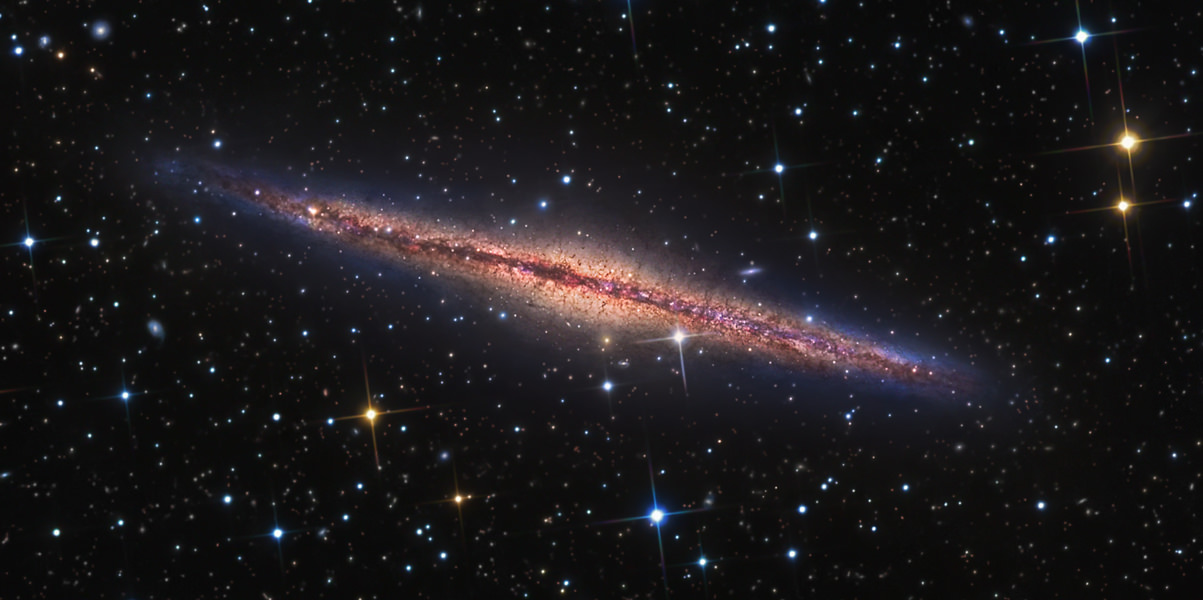[/caption]
This image is a “first light” for noted amateur astronomer R. Jay GaBany’s new observatory, and it might be the deepest, most detailed view of the iconic edge-on spiral galaxy NCG 891. This first photograph from his new observatory in California includes almost 35 hours of exposure time! “As a result, hundreds of small, much more distant galaxies can be seen in the image as well as very small scale structures across the galaxy’s edge,” Jay wrote us. If you go to Jay’s website, Cosmotography.com, you can see larger versions where you can see very faint dust clouds, called cirrus, that have never been imaged within NGC 891 at this scale.
“Last fall, I moved my remote observatory from the south central mountains of New Mexico, where I have been taking pictures for the past five years,” Jay said, “to high in the Sierra Nevada Mountains, between Yosemite and King’s Canyon National Parks, in the east central part of California….For me, the first picture included many test exposures taken to insure my instruments were functioning correctly. As a result, I chose a familiar subject so I could spot problems quickly. Luckily, I had very few challenges and my new remote observatory is now operating both smoothly and reliably!”
NGC 891 is located in the northern constellation of Andromeda. It’s easily visible with a small telescope this time of year and is a favorite subject for astrophotographers. “However, no image of this galaxy (to my knowledge) has gone as deep as this picture,” Jay said.
Also, Universe Today would like to send our congratulations to Jay for being recognized by the American Astronomical Society (AAS) and Sky & Telescope Magazine, as he was awarded the Chambliss Amateur Achievement Award for his work with Dr. David Delgado and his team of professional astronomers! The award is given annually to an amateur astronomer from North America who makes outstanding contributions to scientific research.
Jay was cited as being one of the world’s leading amateur astrophotographers for the past decade, “who has single-handedly, through his dedicated and careful work, spawned a new research direction in the exploration of galaxy evolution via low-surface-brightness imaging of galaxy halo substructure,” the AAS press release said. “GaBany has devoted hundreds of hours working with professional astronomers to make deep images that reveal faint tidal streams and rings in the outer halos of galaxies, indicative of recent and ongoing galaxy interactions with dwarf satellites, supporting studies of galaxy formation.”
Congrats Jay!


R. Jay GaBany’s NGC 891, appearing on a desktop quite near me 🙂
stunning work at full resolution.
Congratulations to Jay for his (well-deserved) Chambliss Award and for his jaw dropping image of NGC 891.
I’m curious to know, given the depth of this exposure, if there are any traces of a faint filamentary stellar stream (signs of a cannabalized dwarf galaxy similar to that seen in NGC 5907) discovered last year? Over 20 hours of imaging using the 8.2 meter Subaru scope revealed:
“The low surface brightness outskirts of this galaxy are populated by multiple, coherent, and vast substructures over the 90kpc * 90kpc extent of the survey. These include a giant stream, the first to be resolved into stars beyond the Local Group using ground-based facilities, that loops around the parent galaxy up to distances of ~50kpc.”
Additionally:
“The bulge and the disk of the galaxy are found to be surrounded by a previously undetected large, flat and thick cocoon-like stellar structure at vertical and radial distances of up to ~15kpc and ~40kpc respectively. ”
The discovery paper (and image, Fig 1) are available here: http://arxiv.org/PS_cache/arxiv/pdf/1002/1002.0461v1.pdf
Perhaps this image will be scrutinized in a future paper with Delgado et. al.
Hello Jon:
Thank you for the congratulations! Yes, I am very much aware of the stellar stream recently reported by a team using the Subaru. In fact, one of the reasons my exposure was 35 hours long was an attempt to recover the stream. Unfortunately, the quantity of local galactic cirrus blocked my view. However, I am not finished with my data. I plan to try a new technique that should ‘remove’ (or at least mitigate) the cirrus from my data and permit me to confirm the stream. Hopefully, I will have more on this in the near future.
@Jay –
Thanks and good luck in your attempt. Strange to hear you have “cloud” problems in the Sierra Nevada Mtns. though. 😀